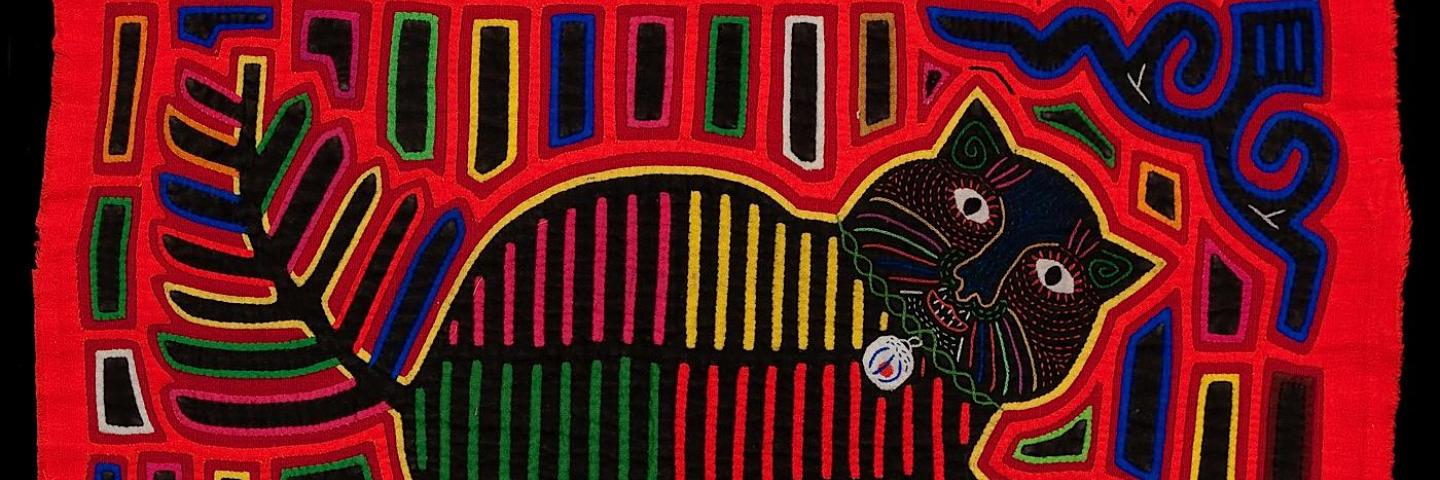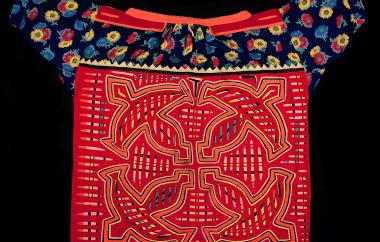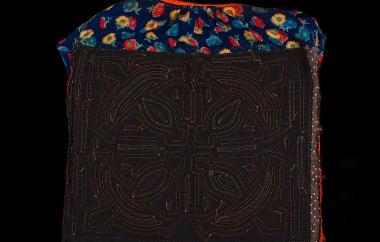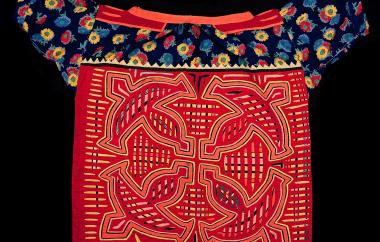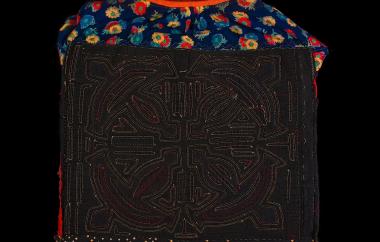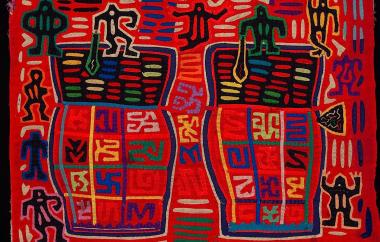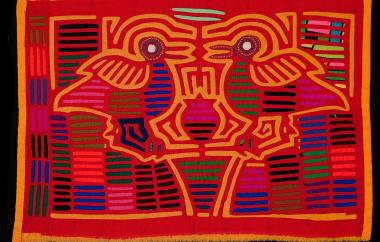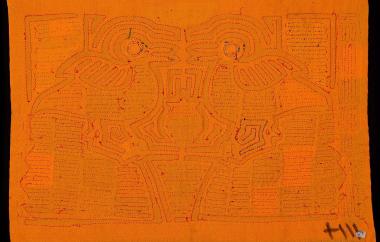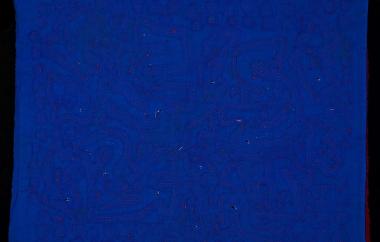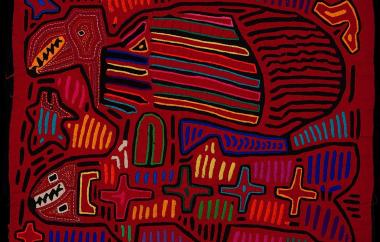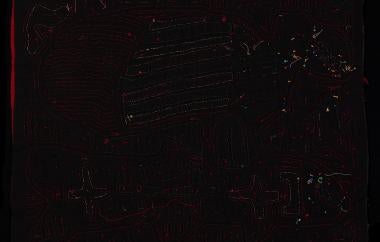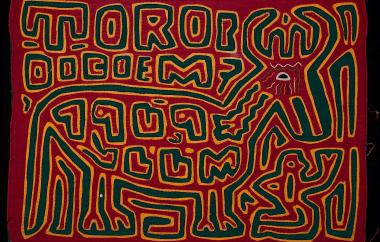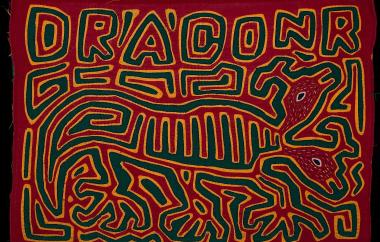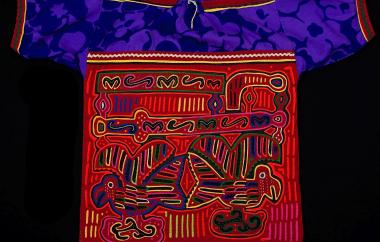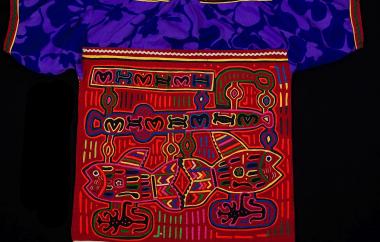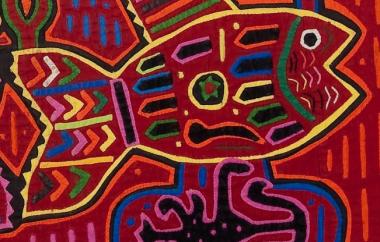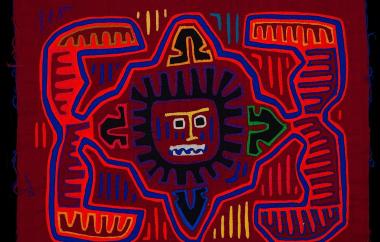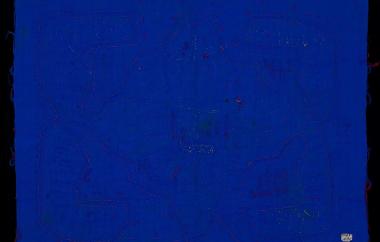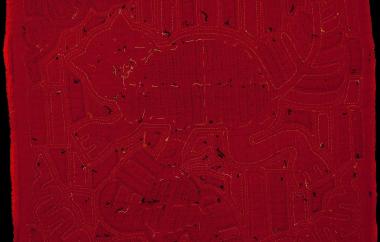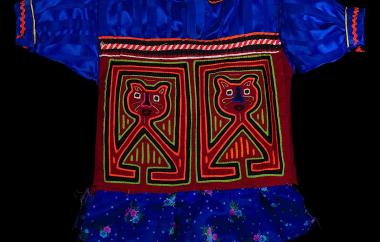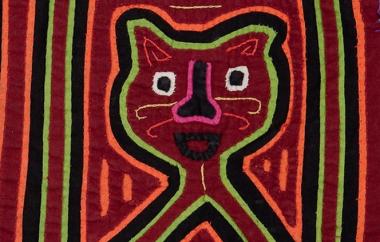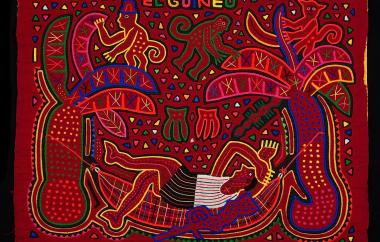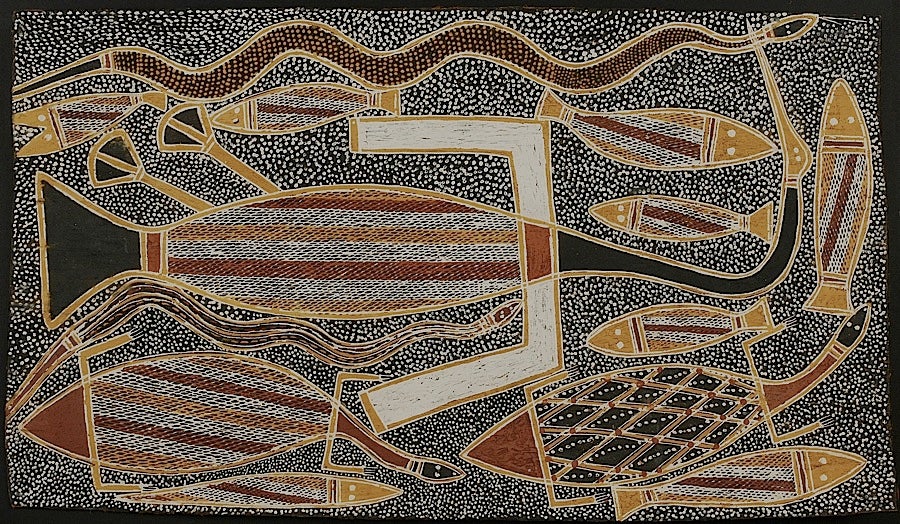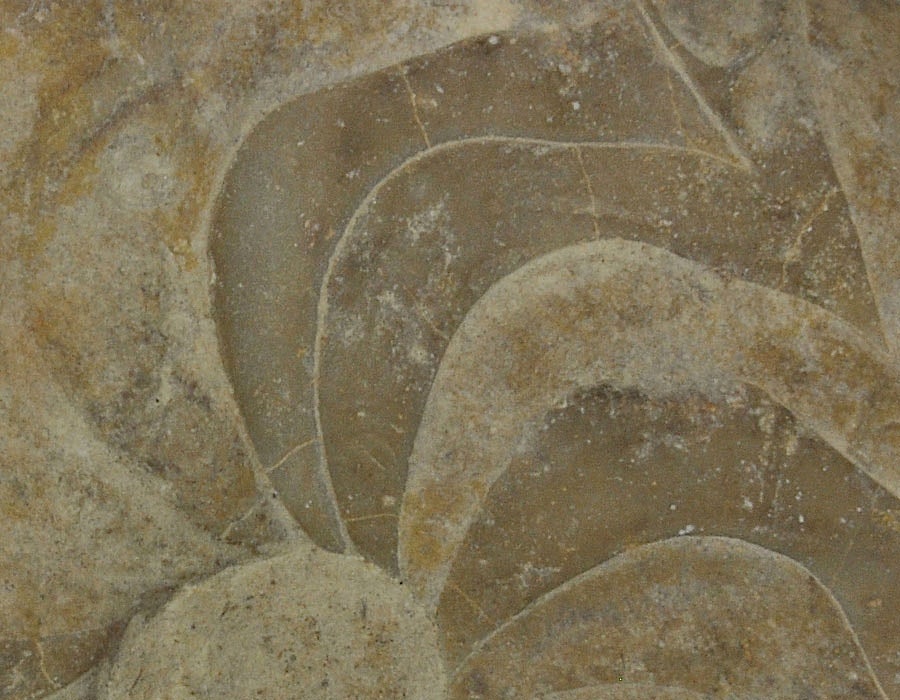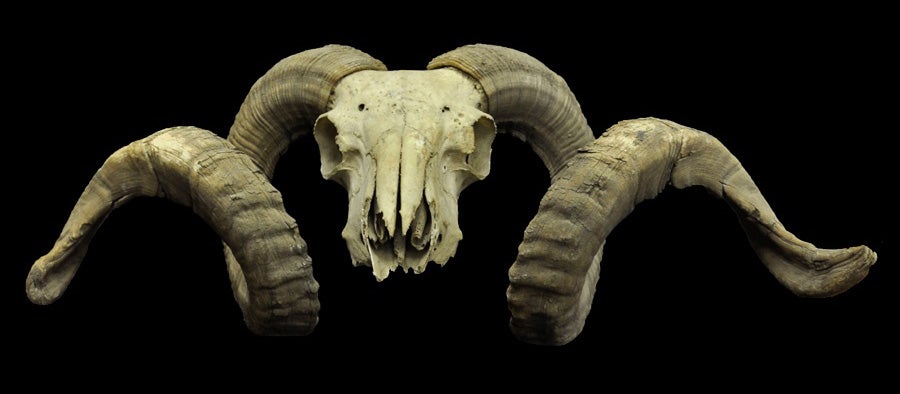Mola, a Kuna word, has several meanings: fabric or cloth, shirt or upper garment for men or women, brightly decorated women's blouses, or colorful layers of fabric, cut and hand-sewn into designs for fronts and backs of Kuna women´s blouses. Kuna women from the San Blas Archipelago produce most of the work, though some molas are also made by Kuna women from inland Panama and western Colombia. Developed in the late 1800s from an earlier tradition of body painting, designs were first painted on cloth and later sewn. Early blouses, dark blue with wide red hems, evolved into those with multi-color designed borders. Borders were widened over time into the rectangular panels of today, and motifs, too, have changed, integrating images from daily life and popular culture. Red, yellow, and dark blue or black remain the preferred colors.
Designs are produced with a combination of reverse appliqué and appliqué. Two or more layers of different colors of cotton cloth are hand-sewn loosely together. The design and its details are cut through the top layer or layers to reach the color selected by the worker. Minute hand stitches attach each folded cut edge to a lower layer. Frequently small scraps of color are inserted beneath the top layer and worked in tas-tas, slits, to emphasize special details of background pattern.
Traditionally worn with a wrap-around skirt (sabured) and a red-and-yellow head scarf (muswe), molas are an important reflection of women´s skills and Kuna identity. Shown here is a sample of molas from the museum collections, including several "inside" views to illustrate technique. Images © UO Museum of Natural and Cultural History. Production of this gallery received generous funding from The Ford Family Foundation.
Further Reading:
Sherzer , Dina and Joel Sherzer
1976 Mormaknamaloe: The Cuna Mola. In: Ritual and Symbol in Native Central America, ed. by P. Young and J. Howe, pp. 23-42. University of Oregon Anthropological Papers No. 9. Eugene.
Salvado, Mari Lyn
1997 The Art of Being Kuna. UCLA Fowler Museum of Cultural History, Los Angeles.
Catalog #3-142
Mola blouse with birds in four-square pattern. (exterior, front)
34 x 21.5 inches - Early style, with narrow sleeves and thin decorative band between panel and yoke.
Bought in 1942, with five layers of cotton fabric on both front and back.
Catalog #3-142
Mola blouse with birds in four-square pattern. (interior, front)
34 x 21.5 inches - Early style, with narrow sleeves and thin decorative band between panel and yoke.
Bought in 1942, with five layers of cotton fabric on both front and back.
Catalog #3-142
Mola blouse with birds in four-square pattern. (exterior, back)
34 x 21.5 inches - Red top layer was added over a completed mola to enlarge the blouse.
Bought in 1942, with five layers of cotton fabric on both front and back.
Catalog #3-142
Mola blouse with birds in four-square pattern. (interior, back)
34 x 21.5 inches - Red top layer was added over a completed mola to enlarge the blouse.
Bought in 1942, with five layers of cotton fabric on both front and back.
Catalog #3-419a
Mola probably depicting a baseball game. (exterior)
20 x 14.5 inches
Catalog #3-419a
Mola probably depicting a baseball game. (interior)
20 x 14.5 inches
Catalog #3-419b
Mola with two birds standing over a flower in a pot. (exterior)
19 x 13 inches
Catalog #3-419b
Mola with two birds standing over a flower in a pot. (interior)
19 x 13 inches
Catalog #3-419c
Mola with aquatic figures. (interior)
17 x 14 inches
Catalog #3-419c
Mola with aquatic figures. (exterior)
17 x 14 inches
Catalog #3-419d
Mola with bird and fish. (exterior)
18.5 x 15.25 inches
Catalog #3-419d
Mola with bird and fish. (interior)
18.5 x 15.25 inches
Catalog #3-419e
Mola with bull and small anthropomorph. (exterior) 17 x 14 inches
Writing includes "TORO," Spanish for bull, and possibly a year designation on the animal.
Catalog #3-419e
Mola with bull and small anthropomorph. (interior) 17 x 14 inches
Writing includes "TORO," Spanish for bull, and possibly a year designation on the animal.
Catalog #3-419f
Mola with large two-headed, three-legged animal. (exterior) 18 x 13 inches
Writing may spell "DRAGON."
Catalog #3-419f
Mola with large two-headed, three-legged animal. (interior) 18 x 13 inches
Writing may spell "DRAGON."
Catalog #3-1177
Mola blouse with two birds, probably in a cage. (full view, front) 31.5 x 22.5 inches
Rayon yoke and sleeves.
Catalog #3-1177
Mola blouse with two birds, probably in a cage. (detail, front) 31.5 x 22.5 inches
Rayon yoke and sleeves.
Catalog #3-1177
Mola blouse with two fish, probably in a cage. (full view, back) 31.5 x 22.5 inches
Rayon yoke and sleeves.
Catalog #3-1177
Mola blouse with two fish, probably in a cage. (detail, back) 31.5 x 22.5 inches
Rayon yoke and sleeves.
Catalog #3-1395
Mola with sun motif. (exterior) 16 x 13 inches
Catalog #3-1395
Mola with sun motif. (interior) 16 x 13 inches
Catalog #3-1296
Mola with cat with collar and bell, catching bird. (exterior) 16 x 13 inches
Chain stitch-embroidered detailing
Catalog #3-1296
Mola with cat with collar and bell, catching bird. (interior) 16 x 13 inches
Chain stitch-embroidered detailing
Catalog #3-1452
Child's mola blouse with two cats. (full view, front) 24 x 18.5 inches
Polyester yoke and sleeves.
Catalog #3-1452
Child's mola blouse with two cats. (detail, front) 24 x 18.5 inches
Polyester yoke and sleeves.
Catalog #3-1452
Child's mola blouse with two cats. (full view, back) 24 x 18.5 inches
Puffed sleeves and wide decorative band between panel and yoke are later innovations.
Catalog #3-1452
Child's mola blouse with two cats. (detail, back) 24 x 18.5 inches
Puffed sleeves and wide decorative band between panel and yoke are later innovations.
Catalog #3-1458
Mola showing man with gun in hammock, monkeys in banana plants. (exterior) 18.25 x 14.5 inches
Spanish “EL GUINEO” refers to the “banana” or "banana plant."
May be paired with next mola (#3-1459).
Catalog #3-1458
Mola showing man with gun in hammock, monkeys in banana plants. (interior) 18.25 x 14.5 inches
Spanish “EL GUINEO” refers to the “banana” or "banana plant."
May be paired with next mola (#3-1459).
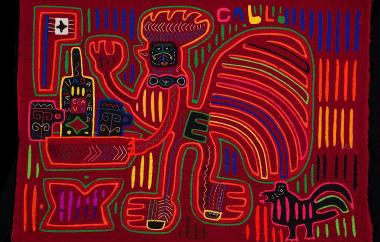
Catalog #3-1459 Mola with anthropomorphic rooster and beer bottle, cups, and flag. (exterior) 19.5 x 14 inches Rooster's shoulder decorations may represent military epaulets. Writing on bottle includes, "Esta criada cerveza," Spanish for "Beer is brewed." A strip was added on the side to enlarge the shirt and is embellished with a smaller bird. May be paired with the previous mola (#3-1458).
Catalog #3-1459
Mola with anthropomorphic rooster and beer bottle, cups, and flag. (exterior) 19.5 x 14 inches
Rooster's shoulder decorations may represent military epaulets. Writing on bottle includes, "Esta criada cerveza," Spanish for "Beer is brewed." A strip was added on the side to enlarge the shirt and is embellished with a smaller bird.
May be paired with the previous mola (#3-1458).
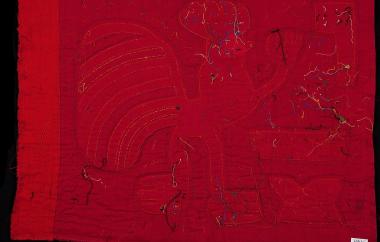
Catalog #3-1459 Mola with anthropomorphic rooster and beer bottle, cups, and flag. (interior) 19.5 x 14 inches Rooster's shoulder decorations may represent military epaulets. Writing on bottle includes, "Esta criada cerveza," Spanish for "Beer is brewed." A strip was added on the side to enlarge the shirt and is embellished with a smaller bird. May be paired with the previous mola (#3-1458).
Catalog #3-1459
Mola with anthropomorphic rooster and beer bottle, cups, and flag. (interior) 19.5 x 14 inches
Rooster's shoulder decorations may represent military epaulets. Writing on bottle includes, "Esta criada cerveza," Spanish for "Beer is brewed." A strip was added on the side to enlarge the shirt and is embellished with a smaller bird.
May be paired with the previous mola (#3-1458).
Catalog #3-1581
Mola with a Santa Claus carrying presents.
17 x 12.5 inches
Catalog #3-1581
Mola with a Santa Claus carrying presents (reverse).
17 x 12.5 inches
Catalog #3-1629
Mola with birds and a human face.
17 x 14.5 inches
Catalog #3-1629
Mola with birds and a human face (reverse).
17 x 14.5 inches
Catalog # 3-1626
Mola with a bird and a deer.
18 x 14 inches
Catalog # 3-1626
Mola with a bird and a deer (reverse).
18 x 14 inches
Catalog #3-1591
Mola with sea creatures.
17 x 13.5 inches
